
24 minute read
Let the Games Begin New trends in industrial grease lubrication
Quimica Liposoluble, S.A. de C.V. A brief summary of ELGI ’s Olympic Performance Meeting in Athens
Dr. Raj Shah - Koehler Instrument Company, Inc.- Holtsville, NY, 11742 US Dr. Mary Moon - Technical Editor, The NLGI Spokesman - Yardley, PA 19067 US Dr. George S. Dodos - Eldon’s S.A. - 14343 Athens, GR June 4, 2019
The European Lubricating Grease Institute held its 31st Annual General Meeting in Athens, Greece (April 13-16, 2019). The AGM site at the Divani Caravel Hotel was located only several blocks from the National Gallery and the National Garden and a 10-minute drive from the historic Acropolis Temple and Museum that overlook the city of Athens. On the evening before the AGM, a formal welcoming reception was held on the rooftop terrace of the venue hotel. This reception gave all attendees the chance to socialize, talk with new and old friends, and enjoy the stunning view of the Acropolis.
Opening Ceremony
ELGI Chairman Terry Dicken, (Global Lubricants Ltd., UK) opened the AGM by welcoming a record-breaking 384 delegates from 32 nations who represented 180 organizations. Dicken reported that ELGI membership is stable with 150 members and a sound financial position operating within budget. He described ELGI as ‘progressive and expanding its scope’ by supporting joint ELGI-NLGI working groups to address topics relevant to the grease industry, establishing an industry-wide consortium for REACH registration of grease thickeners, and regularly publishing a digital technical journal, Eurogrease.
The Acropolis overlooking Athens (Photo courtesy of KRS Photography)
Andreas Adam (Fragol AG, DE), ELGI treasurer, provided a brief but clear review of the audit of the Institute’s financial records. Constantin Madius (Axel Johnson International AB, SE), ELGI Technical Coordinator, discussed the significant work that is taking place within the Working Groups and presaged the possible revival of the Environmental WG, which has been inactive for several years. Each Chairman enlightened the audience about the progress and the outlook of their respective WG. Then, Joe Kaperick (Afton Chemical Corporation, US), NLGI Chairman, Sachdeva Siddharth (Siddharth Petro Products, IN), on behalf of the NLGI-India Chapter,

ELGI Chairman Terry Dicken opened the AGM
and Ray Zhang (Vanderbilt Chemicals, LLC, US), on behalf of the Chinese Lubricating Grease Institute, each delivered an update on the activities of their corresponding affiliated Institute. Kaperick gave a report on the Grease Production Survey and shared insights on global lubricating grease statistics per base oil and thickener types and grease market shares per region. The Opening Session ended with the keynote speech by Aris Gorogias (The Hellenic Association of Chemical Industries, GR), who gave facts and figures on the current situation and an auspicious forecast of the Greek Chemical Sector, underscoring energy efficiency challenges. Greece being the birthplace of the Olympic Games, the AGM theme was ‘Olympic Performance’ of lubricating greases. The program of 15 technical papers focused on advances in industrial lubrication, grease performance, additive technology, environmentally advantaged (friendly) greases, and energy efficiency. Topics related to base oil technology, new test methods, and the reduction of grease carbon dioxide footprint

ELGI Board of Directors at the AGM in Athens, from left to right: Carol Koopman, Rolf Quermann, Terry Dicken, Gaia Franzolin, Leandro Muntada, Manfred Jungk, Andreas Dodos, and Andreas Adam (Photo courtesy of ELGI) via process optimization were also presented. This three-day AGM included 15 technical papers, 5 Working Group Sessions, and a plant tour.
ELGI Best Paper Award
The BPA Committee evaluated 15 papers and presentations on the basis of content, quality of the presentation, embodiment of the spirit of originality and technical innovations, and uniqueness (not presented elsewhere before this Meeting).
ELGI’s Committee unanimously selected the paper and presentation, Grease Production, CO2 Emission…a New Relationship!, as the 2019 BPA winner. This paper was presented by Andreas Dodos (Eldon’s S.A., GR) and coauthored with George Dodos (Eldon’s), Mehdi Fathi-Najafi (Nynas AB, SE), and John Kay (STRATCO, Inc., US).
Dodos told his audience that manufacturing conventional lithium grease is a very energy intensive operation and, surprisingly, little work has been done to study the energy consumption and possible environmental impact of grease production. Energy efficiency of grease manufacturing deserves careful study because carbon dioxide emissions from electric power generation and other activities have been shown to be a major contributor to greenhouse gas emissions and global warming.
The goal of this paper was to measure the energy consumption of industrial scale production of conventional NLGI grade 2 lithium grease and compare the use of a pressurized reactor versus a traditional open kettle reactor. This study also compared naphthenic and Group I paraffinic base oils at two viscosity grades (ISO VG 100 and 220) that are used typically in multipurpose lithium greases for industrial applications. All other process parameters were kept constant throughout the study.
The Authors recorded the total energy - electrical for mechanical operations such as pumping, mixing and homogenizing, as well as fuel for heating - consumed for the entire production process, from vessel charging, cooking, cooling, and diluting to homogenizing. They converted the energy consumption to normalized CO2 emissions for each batch. To validate this study, they tested their finished greases according to the specifications required by typical end users.
Dodos reported an overall 21.5% reduction in CO2 emissions per metric ton of lithium grease made with a blend of ISO VG 220 naphthenic and Group I base oil blends in a pressurized reactor versus nominally identical grease made with paraffinic oil in an open kettle.
He explained that the lithium thickener was more efficient in the naphthenic oil (more product obtained per unit of energy), and the pressurized reactor used approximately one-third less energy than the open kettle (differences in loss of heat and length of time for processing and mixing).
Dodos concluded that this study could be a milestone in assessing grease production in terms of significant reduction of CO2 emissions and increased awareness
Dodos told The Spokesman, ‘We are delighted to receive this award. It was a great honor and we were very gratified. For this work, it was all about the teamwork. We managed to bring together experts from three different sectors in the industry (equipment supplier, base oil supplier, and manufacturer) and the outcome, judging from the feedback of the industry, was extraordinary.’
The Authors talked with The Spokesman about the motivation for their work. They gave credit to Fathi-Najafi’s concept of reducing carbon emissions through costsaving production adjustments. Another motivation was to build upon interesting findings from their lab-scale study, conducted by Mehdi Fathi-Najafi and John Kay and presented at the 2018 NLGI Annual Meeting, and move forward to an industrial-scale investigation. Andreas Dodos added, ‘For Eldon’s, this type of work was pretty much in line within the vision of the Company, namely focusing on the total grease-making operation and not only on the environmental impact of the products.’

BPA Authors and colleague (left to right): Ovidiu Nan (Nynas), Andreas Dodos (Eldon’s), Diane Graham (STRATCO), Mehdi Fathi-Najafi (Nynas), Cecilia Mancero (STRATCO), John Kay (STRATCO), and George Dodos (Eldon’s). (Photo courtesy of STRATCO) Andreas Dodos explained. ‘Moving testing from pilot scale to full scale was not easy. This required a significant amount of resources and a six-figure budget for the project. Also, being able to fit the test batches into the production schedule was not always easy.’ Kay and Fathi-Najafi added, ‘ However, from a technical point of view, predicting soap content adjustment between cases and isolating/measuring energy for each case were the greatest challenges we faced.’
Andreas and George Dodos agreed, ‘Overall, our greatest challenge is to move away from the ‘if it works don’t fix it’ mentality of the grease industry as a whole. We were very surprised by how much difference we found between the test batches and how inefficient the standard industry practice for grease manufacturing is compared to the alternatives we explored.’
What about the future impact of their work? Andreas Dodos noted, ‘Our Company has been involved in three papers that have won the best paper award in the last 6 years. One has led to the introduction of a new ASTM test method for grease. Now, we are hoping that this work will have an impact on how grease manufacturing is evaluated throughout the industry.’
Railroad Track Grease
Lou A. Honary and Saeed ZaherSoleimani (Environmental Lubricants Manufacturing, Inc., US) presented a comparative study of high-pressure vs. low-pressure dispensing systems for applying rail curve greases. Honary reported results from a yearlong field test on a shortline railroad in northern Iowa where extreme temperatures Grease dispensing equipment, also called lubricators, are operated by batteries that are charged by solar collectors. A sensor placed ahead of the lubricators detects the arrival of train wheels and signals the motor to pump grease into delivery bars and onto the tracks.
In this study, lubricators from two OEM’s were tested on opposite S-shaped tracks, one for northbound and one for southbound traffic. The highpressure lubricator had a positive displacement mechanical shovel pump, while the low-pressure lubricator had a gear pump. Engineers used a tribometer to collect friction readings and detect grease on the tracks at different distances from the lubricators. They also measured temperature, grease flow, and other pertinent information.
Honary reported that the highpressure applicator performed better, especially at extremely cold temperatures, in comparison to the low-pressure applicator in terms of delivering the lubricant more consistently within a wide range of temperatures. Grease was carried farther on the track with the highpressure applicator.
Ester Base Oils for Grease
George Dodos (Eldon’s), Paul Bonner, and Kevin Duncan (both Croda International, UK) discussed their results for the effects of different bio-based and biodegradable ester base oils on lubricating grease performance. Due to increased awareness and sustainability initiatives within organizations, bio-based lubricants
are now viewed as a high growth area and have attracted a substantial amount of R&D spending from established suppliers as well as start-ups.
In this study, they investigated the use of four types of renewable (bio-based) esters as base oils for the production of calcium- and lithium-based lubricating greases. They focused on how the esters’ properties changed as they went through the soap greasemaking process. The Authors specifically evaluated the oxidative and hydrolytic of the esters to determine their ability to withstand the production processes and to compare the performance of the final formulated greases. Greases were prepared on a basis of a constant soap content.
They reported that all four esters were capable of producing robust base grease formulations that could be further improved with additives. Only one of the eight base greases (combination of lithium thickener and an unsaturated ester) had unusual properties (relatively high consistency and low dropping point).
While a variety of esters can be used to manufacture greases that satisfy requirements for stability, low temperature properties, etc., it can be advantageous to use an ester that is optimized. Lithium- and calciumthickened greases made with ester D, a special saturated branched ester, had better oxidative stability and higher yields than other greases in this study. Furthermore, results showed the advantage of using a specific ester with the correct viscosity grade (as opposed to blends) to make grease.

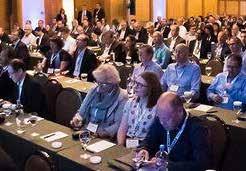
Delegates attended 15 technical presentations
DAWN OF A NEW ANTIOXIDANT VANLUBE® 407
Lubricant Additive
Outstanding Performance in Both Thin-Film and Bulk Oxidation Protection.
30 Winfield Street, P.O. Box 5150, Norwalk, CT 06856-5150
petro@vanderbiltchemicals.com www.vanderbiltchemicals.com (203) 853-1400 (203) 853-1452
Registered and pending trademarks appearing in these materials are those of R.T. Vanderbilt Holding Company, Inc. or its respective wholly owned subsidiaries. For complete listings, please visit this location for trademarks, www.rtvanderbiltholding.com.
VANDERBILT CHEMICALS, LLC CERTIFIED TO ISO 9001:2015 10002461
Measuring Grease Tackiness
Erik Willett (Functional Products Inc., US), Emmanuel Georgiou (Falex Tribology N.V., BE), and Andreas Dodos (Eldon’s) presented data from objective measurements of grease tackiness. According to these Authors, high molecular weight polymers (tackifiers) are added to improve adhesion and cohesion of greases, referred to as ‘tack’ or ‘tackiness’. Adhesion between lubricants and metal surfaces keeps the product in place, and cohesion prevents fling-off from high speed gears. Wire-rope and open gear lubricants are two of the most common applications for tackifiers. Until recently, qualitative, subjective methods such as the ‘two-finger test’ were the only means available to measure grease tackiness.
In this study, an automated Tackiness Adhesion Analyzer (Falex Corp., US) was used to evaluate several tackifier chemistries at various concentrations in calcium sulfonate grease. The TAA operates on the principle of an atomic force microscope, but on a much larger, macroscopic scale. It measure the forces to gradually push a probe into a film of grease on a solid substrate, and then pull the probe back (in the opposite direction) and form ‘threads’ of grease that stretch and eventually break.
Georgiou reported that the TAA demonstrated the ability to discern between a wide array of different polymers and their contribution to thread formation in tacky calcium sulfonate grease. The instrument’s high sensitivity captured many physical measurements while pulling small threads of tacky grease: thread length, pull-off force, compression energy, and separation energy. The study found that thread length and separation energy correlated well with observed tack, but simple pull-off force alone was not adequate to describe the tackiness. Such a method would be useful in formulation and QC of greases where the level of tack integral to different industrial applications.
Wind Turbine Grease
Gareth Fish (The Lubrizol Corp., US) told his audience that with the increasing use of wind turbines for renewable energy generation, there is a need to further improve greases and open gear lubricants for this application. Grease-lubricated WT components include main bearings that support the rotor assembly, electric motors in some pitch and yaw control systems, and shaft bearings on generators.
Fish explained that grease formulations for WT applications must provide protection against micropitting, fretting, and corrosive wear. He discussed issues with developing greases to meet WT specification requirements of friction, low wear, fretting, and corrosion. He also reported on how to formulate bearing greases to pass both standard tests and the Riffel (or Ripple) test, a relatively new test for false brinelling and corrosion.
The Riffel test utilizes a large angular contact bearing, under a high oscillatory thrust loading with no rotation and salt solution pumped through the bearing. At the end of the test, the amount of wear is measured, and the visible corrosion is rated.
First, Fish carried out exploratory work to better understand specifications and test methods for WT bearing greases. He learned that it is necessary to adjust a grease formulation to balance fretting wear, salt water rust resistance, and false Brinelling.
Second, Fish developed fully synthetic lithium complex greases that passed all the basic industry specified requirements for pitch and yaw bearings and, potentially, main bearings. One formulation used low viscosity PAO base oil to solubilize a water-resistant polymer, and the other used an alkylated naphthalene base oil.
A commercial-scale batch of WT grease was manufactured, and it passed all requirements. This grease is now in a field trial to validate its performance under actual service conditions.
Pre-formed Polyurea Grease Thickener
Liwen Wei (Novitas Chem Solutions, US) presented a paper detailing the chemistry and use of a novel thickener for polyurea greases. Wei reminded the audience that polyurea greases are one of the best substitutes for lithium greases, but challenges of handling isocyanate and amine raw materials have discouraged manufacturers. He proposed a new method to make polyurea greases using preformed polyurea grease thickener (PUGT) and conventional processing techniques.

Greece : A land framed by water (Photo courtesy of KRS Photography)
Wei disclosed a novel type of PUGT with markedly improved consistency and thickening efficiency over prior pre-formed polyurea chemistries. As little as 6% of this PUGT can be used to make NLGI grade 2 greases. The process is carried out by heating and mixing PUGT powder with a variety of base oils without toxic isocyanates and hazardous amines.
A proprietary, patent pending method was used to make a series of PUGT’s from a variety of primary and secondary amines and alcohols. Each PUGT is ‘tuned’ for manufacturing grease with a specific consistency. Wei claimed that these PUGT’s are odorless, colorless fine powders, and they can be used to form pre-mixes in fluids.
Wei explained a two-step process for using PUGT’s to make grease. First, PUGT is mixed thoroughly with base oil and additives to obtain maximum thickening. Second, additional base oil is added to obtain the desired consistency. Milling is important in both steps.
Choice of base oil in the first stage is particularly important to obtain good gelling and thickening efficiency and yield. Wei recommended AN (alkylated naphthalene), AB (alkyl benzene), and PAG (polyalkylene glycol) base oils for best thickening efficiencies, yields, and milling characteristics. He cautioned that insufficient process conditions and improper PUGT dosage in the first stage would lead to much more milling and lower grease yields in the second stage.
Finally, Wei showed data for mechanical stability (change in cone penetration after working 50 strokes) and high temperature stability (ASTM D1831) for four NLGI grade 2 greases, one grease made with PUGT powder, and three commercial products made ‘from scratch’, i.e., from isocyanates and amines reacted in situ to synthesize polyurea thickener during grease making. Wei concluded that the performance of his PUGT-thickened grease was superior to one of the commercial polyurea greases and comparable to the other two products.
According to Wei, this PUGT technology offers ‘a quantum leap forward’ in the manufacturing of polyurea grease.
mPAO Advantages for Greases
Paul A. Bessette (Triboscience & Engineering, Inc., US) and Ken Hope (Chevron Phillips Chemical Company LLC, US) coauthored a paper about the use of mPAO 65 base oil to formulate greases from lithium, preformed polyurea, and aluminum complex thickeners. These various greases have many industrial uses, and mPAO 65 provided many benefits in each of these lubricating greases.
While high viscosity PAO’s have been commercially available since the 1980’s, mPAO’s are relatively new with commercial grades available since 2011. The physical property advantages of the mPAO’s compared to traditional high viscosity PAO’s are a higher viscosity index with lower pour point and better low temperature viscometrics.
The main objective of their lithium grease study was to evaluate the use of mPAO base oils in comparison to traditional high viscosity PAO base oils in lithium grease. They compared test data for lithium greases prepared with PAO 6/PAO 40 blends versus PAO 6/mPAO 65 blends. The low temperature viscometrics, as well as the starting and running torque measured at low temperatures, were highlights of the lithium greases. The PAO 6/mPAO 65 lithium grease had superior low temperature properties due to both a lower amount of the high viscosity base oil as well as the superior low temperature properties of the mPAO.
The polyurea grease prepared with mPAO demonstrated the ability to prevent copper discoloration during 24 hours at 100 C despite there being no yellow metal passivator additives present in the formulation.
Finally, the oxidative stability of the lithium polyuria and aluminum complex mPAO-based greases exhibited excellent performance.
Graphene-based Lubrication
Florian Pape (Institute of Machine Design and Tribology, DE) presented a paper on graphenebased lubrication for rolling element bearings. Graphene consists of two-dimensional layers of covalently-bonded carbon atoms. It offers advantageous properties such as high strength and electric conductivity. The two-dimensional, layered structure of graphene can be effective against friction and wear under sliding conditions. Graphene coatings have shown promise for reducing friction and wear under rolling conditions.
For this investigation, Pape tested thin films of graphene platelets as dry lubricants on the raceways of angular contact ball bearings. He suspended 0.1 wt% graphene in
DMF (N, N-dimethylformamide), applied this mixture to bearing races and rolling elements, and heated them to form a dry coating of graphene.
In addition, he stirred 0.1 w% graphene into barium complex soap thickened synthetic hydrocarbon based grease and used the grease to lubricate bearings.
Experimental studies were carried out under oscillating conditions with a test rig described in his paper. Laser scanning microscopy was used to investigate wear phenomena. Additionally, frictional properties were measured with a tribometer.
Pape concluded that graphene platelets as dry lubricants offered excellent wear resistance in rolling contacts under reciprocating motion. He noted that laser scanning microscopy results showed that the graphene layer thickness on metal was significantly lower compared to conventional transfer layers. Thus, graphene can also be used for bearings without having to increase the bearing clearance. In the case of the graphene-additized grease under oscillating motion, advantages were also obtained.
Pape proposed that graphene dry lubrication for bearings showed potential for applications in the aerospace industry, under vacuum, at high and extremely low temperatures, and in the event of failure of liquid lubricants. He claimed that his results proved that graphene is suitable for use in rolling bearings that are operated under pivoting motion and in joints. His study confirmed that the excellent properties of graphene, which have so far been proven with nano- and micro-scale test benches, can be transferred to macroscopic applications such as those found in various machine elements.

Local Orthodox church(Photo courtesy of KRS Photography)
Working Group Sessions
On Sunday morning, various Working Groups assembled for meetings.
First, Grease Particle Evaluation WG Chairman Joe Kaperick gave an update on the Hegman gauge study and recent round robin study. Repeatability was very good, while significant deviations were observed between participating labs for a number of grease samples. It was suggested that it might be helpful to run a round robin with HD photos of the Hegman gauge determinations of problematic samples. A draft method for grease particle evaluation could be discussed in the next ASTM standards meeting on June and prepared for balloting in the ASTM process. Volunteers were requested to help with the drafting of a white paper that will give guidance on the various methods available for particle evaluation.
Second, Food Grade Lubricants WG Chairman Andreas Adam was re-elected as chairman for one more year. The WG discussed food contamination by mineral oil saturated (MOSH) and aromatic (MOAH) hydrocarbons, update on the IP346 method, trends on future legislation, and the ILSI role. There was a comprehensive round table discussion about questions relevant to food grade lubricants and incidental food contact from end users. Volunteers were asked for input on these subjects for a possible future article for TLT.
Third, Biobased Greases Performance WG Chairman George S. Dodos reviewed the final report on the oxidation stability project and underscored the significant contribution of the WG to the new ASTM test method, D820618 Rapid Small Scale Oxidation Test (RSSOT). The project on the cold temperature performance of biobased greases was discussed. Lists of candidate test methods and critical points were finalized. Results of a preliminary study were presented by Mikael Kruse (AXEL Christiernsson AB, SE), and certain details on test conditions and test sequence will be examined further. Hydrolytic stability evaluation of biobased greases is a new work item.
Fourth, Test Methods and Rheology WG Chairman Olav Hoeger (Shell Global Solutions Deutschland GmbH, DE) updated the WG regarding the ISO/TC28 WG on the development of test methods for greases. A new work item on grease sampling is underway. Concerning the ELGI reference grease, a survey with a list of candidate test methods was distributed for members to vote on their choice. Updates were given on rheological measurements vs. consistency, copper corrosion, oxidations stability, dropping point, and EMCOR tests. Issues with new bearing sources for the Fafnir fretting rig were discussed.
Finally, Railway Lubricants WG Chairman Alder da Costa D’Ambros (Total Lubricants, FR) gave an update on progress toward a European standard for top-ofrail grease. Marc Ingram (Ingram Tribology. UK) has developed a new test method for top-of-rail grease that uses a rig based on the MTM Mini Traction Machine (PCS Instruments, UK). The aim of Ingram’s test is not to replicate the railway but rather to establish a performance baseline for products. The next step will be a round robin study of the test method.
Gala Dinner and Entertainment
The second day of the AGM concluded with the Gala Dinner. Greek hospitality prevailed in a fascinating landscape outside of Athens. The event took place in the vineyards of Oenotria Land, a famous Greek winery. Upon arrival, the guests were welcomed by a Greek folk dancing group performing traditional dances and encouraging everyone to join in. Moreover, a travel in time through the history of the vine and the wine could be experienced, by visiting the Costa Lazaridi Wine Museum. Soon after the actual dinner – with a menu of Greek tastes – the night evolved into a joyful party. Almost everyone kept dancing till the end over the music played by the enthralling band “48 ores” and Greek spirits accompanied the high-spirited mood of this event.
Plant Tour
At the end of the meeting, a group of registered attendees had the chance to tour one of the TITAN Group’s cement plant close to Athens. TITAN Group (GR) is a multinational producer of cement and building materials. Plant Manager Faidon Prokopios gave a warm welcome to everyone, and
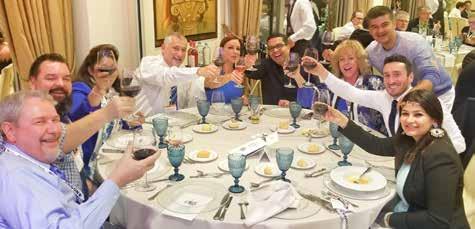
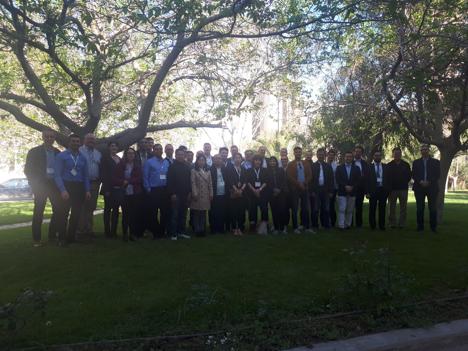
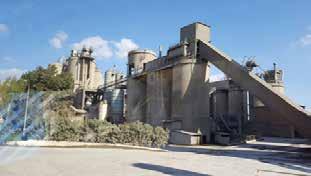
Photo of the group on the cement plant tour.
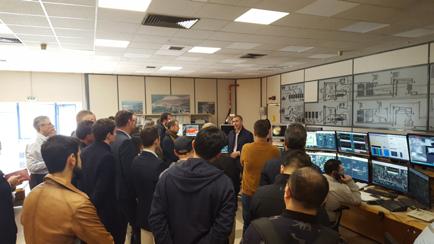
Photos of the cement plant tour
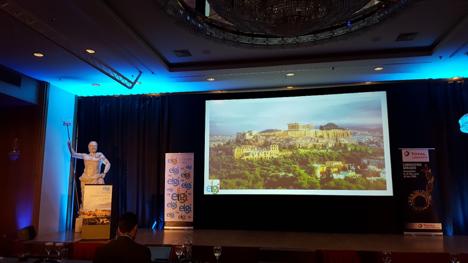
ELGI attendees enjoyed a night out at a tavern in Athens with traditional Greek folk songs and cuisine
then he elucidated technical matters related to cement properties, cement production, the operation procedures of the plant, and its environmental impact. Attendees learned about the lubrication requirements of the several cement production processes. The plant tour included a coach tour of facilities and a visit to the laboratory and the control room.
Partner Tour
A partner tour was organized on Monday morning. The day included sightseeing of historic and modern attractions in Athens, a lunch by the sea, and a tour of the Athens Riviera. The tour included the Panathenaic Stadium and the Stavros Niarchos Foundation Cultural Center. The Panathenaic Stadium is an ancient stadium that was refurbished in the 18th century in order to host the first modern Olympics in 1896. It is the only stadium in the world built entirely of marble. The Stavros Niarchos Foundation Cultural Center is a complex that opened in 2017, and includes the new facilities for the National Library of Greece and the Greek National Opera, as well as the 210,000 m² Stavros Niarchos Park.
Future Events
The next ELGI AGM is planned for April 25-28, 2020 in Hamburg, Germany.
Acknowledgements
Dr. Raj Shah is a Director at Koehler Instrument Company in NY for over 2 decades, a NLGI board member from 2002- 2017, and an elected Fellow of STLE, RSC, AIC, EI and NLGI. More information on him can be found at https:// www.gulfcoastconference.com/ speakerBio.php?pid=7108&y=2019 Dr. Mary Moon is Technical Editor of The NLGI Spokesman, a contributor to Lubes’N’Greases magazine, and a freelance writer and consultant. She has hands-on experience formulating, testing, manufacturing and marketing lubricants and additives. Contact her at MaryMoonPhDMBA@gmail. com or +1-267-567-7234. Dr. George Dodos is the head Chemical engineer at Eldon’s in Athens, a longtime member of ELGI, and coauthor of the best paper award at ELGI 2019 conference
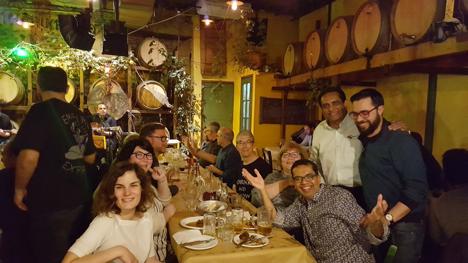
FIRST ANNUAL NLGI Hands-On Education Course
SEPTEMBER 17-19, 2019
Koehler Instrument Company, Inc. | Holtsville, New York
The class is taught in a participatory atmosphere, comprised of a Lecture section and a hands-on Laboratory Practical section where participants perform the prescribed test methods using the required instrumentation. Each participant will receive a course workbook upon arrival. Each day following the morning lecture section, participants will perform a selection of test methods discussed during the day using the required instrumentation. This hands-on approach will reinforce the topics and subject matter discussed during the lecture session to enhance learning and retaining knowledge.
REGISTRATION FEES:
$699 for NLGI members $799 for non-members
*$100 discount may be applied toward membership dues if joining before 12/15/19.
Registration fee includes: • Course Workbook • Roundtrip transportation provided by the Courtyard by Marriott • Lunch & Reception • Lubricating Grease Guide
QUESTIONS?
Contact NLGI HQ at 816-524-2500 or nlgi@nlgi.org
TARGET AUDIENCE:
• Scientists • Plant Supervisors • Laboratory Personnel • Engineers • Senior Technical Staff • Maintenance Supervisors • QC Staff • Senior Plant Operators
This course provides an excellent overview of the types of greases, thickeners, base oils and additives. The methods of manufacturing, testing methodology and their use in bearings and in industrial and automotive applications are also covered.
TOPICS:
• Course Overview & Introduction to
Greases • Application Problem Solving • Grease Manufacturing Overview • Grease Testing • Automotive Applications • Industrial Applications • Grease Selection and
Recommendations • Special Tests • Applications: Grease Tribology • Grease Composition - Base Oil Basics - Thickener Basics - Additives
View SCHEDULE, HOTEL INFO AND REGISTRATION DETAILS online:
https://www.nlgi.org/education/september-education-course/








